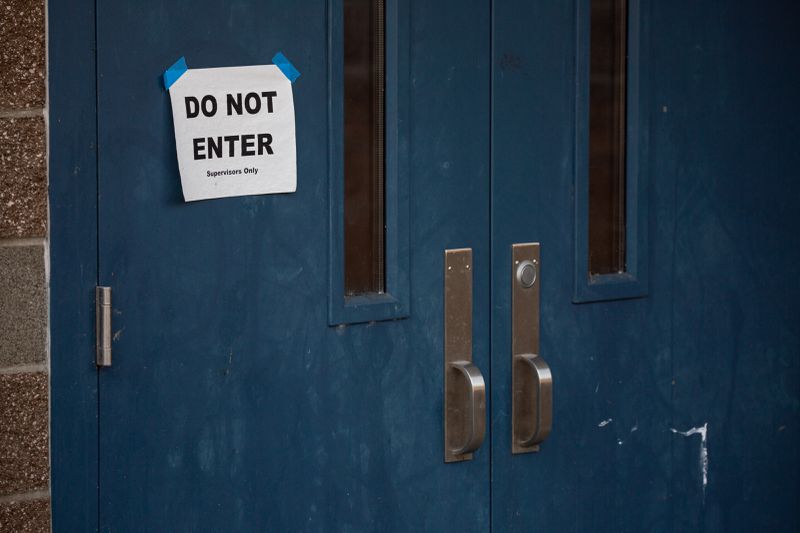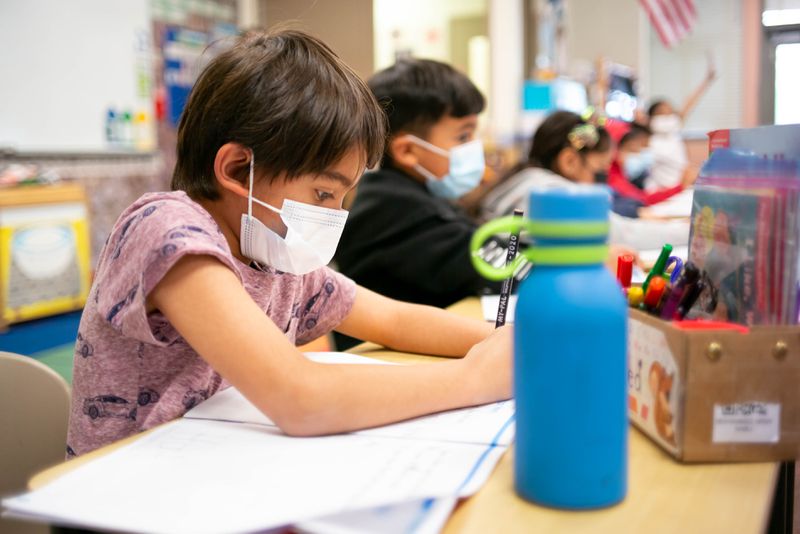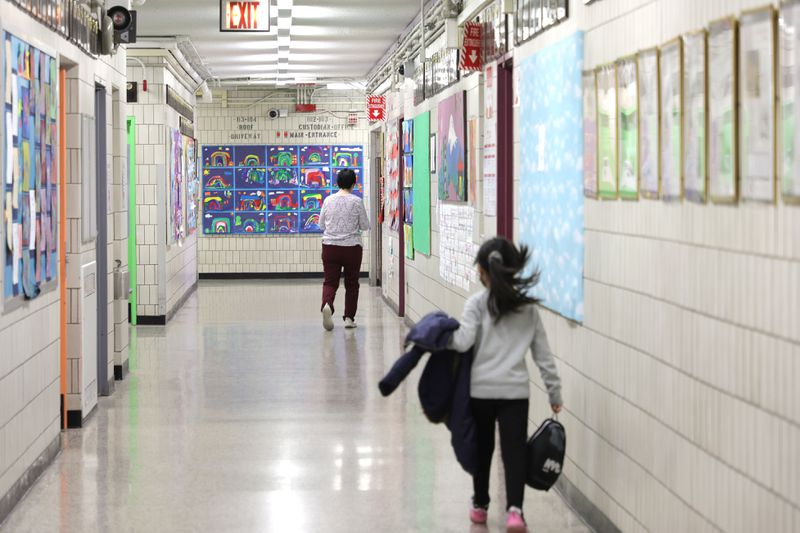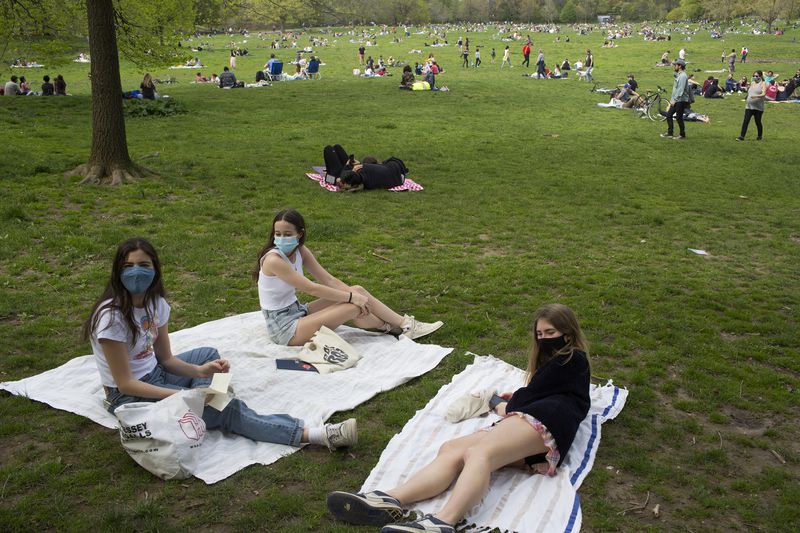
The pandemic took young people’s present. What will it do to their future?
It began on February 27, 2020. That day Bothell High School in Washington — the state where the first confirmed US cases of the novel coronavirus had occurred — announced it would close down temporarily after a staffer’s relative became ill after traveling internationally, prompting fears about what we were coming to understand was Covid-19.
By March 15, New York Mayor Bill de Blasio, in a tense Sunday evening press conference, told students, parents, and teachers at the nation’s largest school system that “there is no school tomorrow.”
By March 25, every public school building in the country had been closed, taking more than 50 million students out of the classroom.
And so the US began an emergency experiment, one with no precedent and no foreseeable end, in what would happen to America’s children if we took away the place where they spend, on average, over a thousand hours a year.
It can be difficult to remember now — after years of increasingly vicious political debates, after the war of epidemiologists against economists, after the mea culpas and the hysteria — that one of the few things most Americans agreed on in mid-March 2020 was this: For our children’s sake, we had to close the schools.
In the spring of 2020 the novel coronavirus was truly novel — there were no vaccines, no clear treatments. America didn’t even have reliable tests. It wasn’t clear yet who would be most vulnerable to infection, how deadly the disease was, or precisely how it spread. Schools could be incubators for infectious disease, something that was made clear every winter flu season. If the price of keeping children safe was interrupting a few weeks or even months of schooling, that seemed a price that parents, teachers, and politicians from both sides of the political aisle were willing to pay.
What we now know, nearly three years later, is that the children were safer than we thought. Americans under the age of 18 have accounted for less than 0.3 percent of Covid deaths. They weren’t invulnerable to the disease — children made up over 17 percent of all cases, severe infections and tragic deaths did happen, and had school somehow continued unchanged, those numbers surely would have been somewhat higher. But thanks to some fortunate roll of the genetic dice, young people were largely spared the direct effects of Covid.
But if Covid didn’t target the young, the pandemic itself — and many of the measures the US took to fight it — will have long-lasting effects on them that we are only beginning to reckon with. The loss of the pedagogical and social structure of the classroom, the drag of often inferior, jerry-rigged remote education, the pain of losing caregivers to the disease, the epidemic of mental health problems linked to pandemic isolation — it all adds up to generational trauma that can’t be captured by any epidemiological curve.
According to nationwide test scores of 9-year-olds released this fall as part of the National Assessment of Educational Progress (NAEP) Long-Term Trends report — which has tracked educational progress in the US going back to the 1970s — the rough equivalent of two decades of advancement for American students in reading and math was erased in just two years of deeply disrupted pandemic-era schooling.

David Ryder/Getty Images
In surveys, school guidance counselors from around the country were united in reporting that their students were showing more signs of depression and anxiety than before the pandemic. A new survey from the Pew Research Center at the end of January found that the mental health of their children is now the top concern of parents, with four in 10 saying that they are extremely or very worried that their children might struggle with anxiety or depression.
This pandemic will end eventually, but its effects on young people will last far longer. Lost education doesn’t slow down children, but permanently sets many of them back — fewer will go to college, while more may have ended up dropping out before high school graduation. One study found that the average American student could lose the equivalent of $70,000 in lifetime earnings if nothing was done to stem the effects of learning loss.
That may not sound like a lot over the course of an entire working life, but the average hides those who will be put permanently off track because of the pandemic. And it’s set to be especially damaging for poor students of color who have suffered disproportionately from learning loss, just as many of their family members did from Covid.
What this means is that paradoxically, the age group that was most resistant to the virus itself may be the group that pays the biggest price over the longest term. Call it the “other long Covid” — and it’s something the US is only beginning to grapple with.
When school stops
To comprehend pandemic learning loss — and understand why that term doesn’t quite describe what happened to the nation’s tens of millions of students through the pandemic — you have to remember what it is like to be a student.
Imagine you miss a day, a week, a month, or more of work. While you’re gone, the work mostly continues, as colleagues mostly pick up the slack. Work is a conveyor belt, and it keeps on rolling; slower, perhaps, if you’re not at your station, but roll it does. When you get back, you’ll need some time to catch up on the latest projects, the gossip, the emails. But you, as a worker, will be mostly the same — the same skills, the same grasp of your job.
Education doesn’t work that way. When it functions best, education is less akin to a conveyor belt than the construction of a building. Just as you need the foundation before you lay the first floor, and the first floor before you put in the second, in school you need basic math before you move onto fractions, reading before you can easily move to writing. And all of that takes place on a clock. There’s a reason we refer to “second-grade reading level,” or “high school equivalency.” As students age, they’re educated, and as they’re educated, they advance, one brick on top another.
What happened in March 2020 is that the building stopped — but the students kept aging, missing their chance to add that next layer. Nearly every classroom in the country remained closed for the rest of the 2020 school year. By late October 2020, more schools were in all-virtual mode than either hybrid or full in-person, according to the data company Burbio’s school tracker.

MediaNews Group via Getty Images
It would take until almost February 2021 until more students were in traditional, five days a week in-person schools — in theory at least — than those who were in all-virtual classes. In Los Angeles, home to the nation’s second-largest school system, students didn’t see the inside of a classroom until April 2021, after more than a full calendar year.
One survey found that on average children missed 26 days’ worth of school through the first half of the 2021-22 school year, while a New York Times survey found that in January 2022, in the midst of the omicron outbreak, a majority of students were at home for at least three days, while almost one in 10 were out for half the month or more.
How Zoom fell short
In theory, of course, students who were out of school from the first panicked days of the pandemic to the endless weeks of omicron were still supposed to be in school — just remotely. And it’s worth remembering just how heroic an effort this was, as teachers and principals with little support and less training tried to figure out how to translate their pedagogical efforts to the age of Zoom.
But for the vast majority of students, remote schooling was a pale substitute for the real thing.
Let’s return to NAEP scores, this time for separate assessments that have tested a wide sample of the country’s fourth and eighth graders since the early 1990s. When the assessment test scores were released last October for the first time since 2019, average math scores for eighth graders had fallen by eight points, the steepest decline ever recorded. Thirty-eight percent of eighth graders were rated below “NAEP Basic” level in math — the most rudimentary level of mastery — up from 31 percent in 2019; 25 percent of fourth graders fell below basic in 2022, up from 19 percent in 2019.
Reading proficiency, which had been on the decline even before the pandemic, wasn’t any better, and not a single state showed meaningful improvement from before the pandemic. The declines were, as Secretary of Education Miguel Cardona said, “appalling and unacceptable.”
Test scores, though, are raw figures; a better way to think of what happened to America’s students during the pandemic is time lost as a learner due to time lost in education. According to Georgetown University’s Edunomics Lab, which calculated the results based on a mix of how long a district operated in remote or hybrid and prior student performance, students in Los Angeles lost the equivalent of 22 weeks of learning in math and 18 weeks of learning in reading. In New York City, it was 16 weeks in math and 13 weeks in reading. In Miami-Dade, it was 10 weeks in math and eight weeks in reading.
To which you might say, as some critics did, so what? If students in 2022 were judged to be roughly as proficient in math and reading as their counterparts two decades ago, well, it’s not as if American kids in 2002 couldn’t read or write (though not as well as the students of 2019). If students had lost the equivalent of multiple weeks or even months of math and reading ability, well, there was surely time to make that up. The young, after all, have nothing but time.
But that attitude fails to appreciate what students really lost when they lost school. “Learning loss” may be the term experts agreed on when describing the effect of pandemic school disruptions, but for the most part, students didn’t suddenly lose what they had already achieved before the pandemic.
Rather, they lost the opportunity and the time to build on what they knew. And while that may have been a temporary hindrance for high-achieving students who had the support at home to catch up, it was nothing short of catastrophic for marginalized students of color who before the pandemic might have had the resources of their school, and little else.

Michael Loccisano/Getty Images
In the NAEP data, students who were already in the bottom quartile lost more ground than top students, meaning the pandemic widened an already yawning gap in American educational achievement and performance.
For fourth graders, while the average reading score fell by three points, students in the top 90th percentile didn’t fall at all, while those in the bottom 10th percentile fell by six points. Black and Hispanic students, who were already behind white and Asian students on average, fell behind even further.
And that’s where the issue of progress really matters. Based on test scores, American students really had improved over the past two decades — and much of that improvement came from progress among Black, Hispanic, and low-income students. The pandemic didn’t just set back America’s students as a whole; it particularly set back those who had made, as a group, the most comparative progress in recent decades, and who could least afford to lose that progress.
As bad as these numbers are, they obscure some of the factors behind that damage that go beyond the facts of epidemiology or the scores on an assessment test — especially for students of color. While more than 200,000 Americans under the age of 18 had lost a caregiver to Covid by the end of February 2022, Black and Hispanic children experienced that loss at nearly twice the rate of white children. Just as American students experienced Covid education disruptions very differently based on who they were and where they lived, the same was just as true for the pandemic as a whole — and that clearly influenced remote schooling decisions as much as any teachers’ union or city politician.
And that’s a fact Americans have to keep in mind as they assess the damage that Covid did to America’s youth. It wasn’t merely that the pandemic disrupted education, whether within a classroom or in front of a computer screen. It was that the pandemic disrupted life — and if children didn’t necessarily suffer directly from the pandemic, they suffered plenty from those disruptions and tragedies.
A lost generation
In the years leading up to those first school closures in March 2020, American students, for the most part, were doing better. Their scholastic progress wasn’t perfect, it wasn’t equitable, and it wasn’t uninterrupted — but it was happening. The same, though, could not be said about how they were doing in ways that can’t be measured on standardized tests.
By now, the belief that America’s children — and especially its adolescents — are in the midst of a historic mental health crisis is commonplace. But it’s worth pausing on just how bad things had gotten.
In 2018-19 data from the National Survey of Children’s Health, 15 percent of adolescents reported having a major depressive episode over the past year, numbers that have increased significantly over the past couple of decades. Suicide rates for people ages 10 to 24 increased 57 percent between the first years of the 2000s and 2018. Feelings of hopelessness and suicidal thoughts rose by about 40 percent among young people in the decade leading up to the pandemic. Nor was it just teenagers — between 2007 and 2016 the rate of children ages 10 to 14 being taken to the emergency room with a mental health disorder rose nearly 64 percent.
The causes were as varied as the individual stories of suffering they created, but one common trend was the growing isolation of children, especially adolescents, as they spent less and less time with each other, and more and more time in the digital world. Experts are still divided on whether there is something uniquely toxic about social media for young people, but as much as online life gets in the way of in-person socializing, it isn’t healthy for adolescent development.
Then the pandemic came, and we took all those trends and maximized them. That meant not just remote school, with a classroom replaced by a computer, but the cancellation of sports, of social events, of so many of the opportunities children and teens have to connect with each other.
Instead, they had screens — according to a 2022 study, average screen time rose by 84 minutes per day during the pandemic, adding up to a mean time of almost four hours a day. Add that to the inescapable trauma of the pandemic itself, especially as it dragged on for months, and what was already a crisis was only compounded.
Take your pick of the data. Compared to 2019 levels, mental health-related emergency department visits rose 24 percent for kids ages 5 to 11, and 31 percent for adolescents ages 12 to 17. After a drop in the first months after lockdowns, suicide attempts began to rise, especially among girls. A 2022 study that looked at children and adolescents in 11 countries, including the US, linked a rise in mental and physical health problems to school closures and social lockdowns.
As with learning loss, the greatest burden of pandemic-era psychological trauma fell on those with the least support to handle it. Even before Covid, suicide rates were rising among Black youth faster than any other racial or ethnic group, yet they saw a steeper decline in the utilization of mental health services than white children.

Corbis via Getty Images
As with learning loss, it’s difficult to say how much of this was preventable. The years 2020 to 2023 saw trauma after trauma inflicted on Americans, from more than 1 million deaths from Covid itself to the sharp economic downturn in the initial stages of the pandemic to the racial reckoning that began in summer 2020.
If someone came out of those experiences without their mental health taking a hit, they’re the rare exception. But it is children who were thrust into this ordeal with little experience and less control over their lives, and it is children who will have to bear the fallout for the longest time.
Reaching next to normal
It will take years to assess the full effects of the pandemic and everything around it on America’s youth, but already some of those harms are at risk of being locked in.
An estimated 1 million students didn’t just experience learning loss; they lost school altogether, dropping out or disappearing, an outcome disproportionately seen among Black and Hispanic students. They were also more likely to be among the growing number of students who postponed or canceled college enrollment during the pandemic, which cuts them off from what is still one of the surest paths to the middle class. Students currently in college struggle, both because school closures disrupted the high school classes meant to prepare them for higher education and because lockdowns disrupted the development of the social skills needed to thrive in college.
Over the long term, all that loss — lost school, lost development, lost support networks — adds up. A 2021 report from the World Bank, UNESCO, and Unicef estimated that the global generation of students who have lived through Covid could lose the equivalent of $17 trillion in lifetime earnings, equivalent to 14 percent of the current global GDP.
Another report from McKinsey estimated that in the US alone, the economic impact of earnings loss from school disruptions could add up to as much as $188 billion every year as those students entered the workforce — unless steps were taken to address learning loss.
Some of those steps are being taken. Congress allocated $190 billion to target learning loss — its largest-ever one-time investment in schools, enough to provide more than $3,500 for each student in the country’s K-12 public schools. But that money has a deadline — districts need to assign all of that funding by September 2024.

Boston Globe via Getty Images
The good news is that evidence suggests that with remote classes behind us, learning has largely picked up its pre-pandemic pace again. But remember that education isn’t a conveyor belt; it’s a building, and many students who lost the opportunity to lay vital pieces of groundwork will remain behind unless we can help them build faster.
Just as the cause of pandemic-era learning loss was, in essence, not enough school, the remedy will likely be more — think double shifts to catch up on a construction project that has fallen behind schedule. But notions to extend the school year, perhaps through additional summer classes, would be costly, and have run into opposition from parents and teachers.
A better option, one increasingly borne out by research, would be a truly nationwide tutoring effort, with high doses of in-school, small-group learning. Such individualized, intensive tutoring programs have been shown to double or triple the amount of math high school students learn each year — precisely the kind of accelerated education needed to close the gap of learning loss.
Matthew Kraft, a professor of education and economics at Brown University, estimated that creating and running a universal K-12 tutoring program would cost about $50 billion a year. That’s far more, and over a far longer time frame, than Congress has allocated for schools in the aftermath of Covid. But given the kind of economic and social pain it might help avert, it seems more than worth it.
America’s kids, if given the support they need, can bounce back from this experience. After Hurricane Katrina hit New Orleans, many of the city’s public schools were closed for months, with the median student forced to evacuate losing about five weeks of instruction on average and on top of the hellish experience of the storm itself. When New Orleans schools reopened in fall 2006, kids came back with significant learning loss, especially in math.
But thanks in part to a sustained, targeted tutoring program, students were able not just to make up for much of what they lost, but to even improve. High school graduation rates increased, as did college attendance. The trauma of Katrina couldn’t be erased, any more than these hellish last three years. But the experience showed that what was lost can be regained.
As a country, the US is slowly coming to grips with the need to spend now to tackle challenges that threaten to darken the future tomorrow. That’s why Congress allocated hundreds of billions of dollars last year to the climate change-focused Inflation Reduction Act. What the country faces now with the tens of millions of young people suffering through the long knock-on effects of the Covid pandemic is every bit as meaningful, for the nation’s future, and for those who are meant to be that future.
----------------------------------------
By: Bryan Walsh
Title: The other long Covid: The damage done to a generation of schoolchildren
Sourced From: www.vox.com/the-highlight/23584869/covid-coronavirus-school-closures-remote-education-learning-loss-psychological-depression-teens
Published Date: Tue, 21 Feb 2023 11:11:26 +0000
Did you miss our previous article...
https://consumernewsnetwork.com/politics-us/george-santos-campaign-expenditures-did-not-match-the-start






